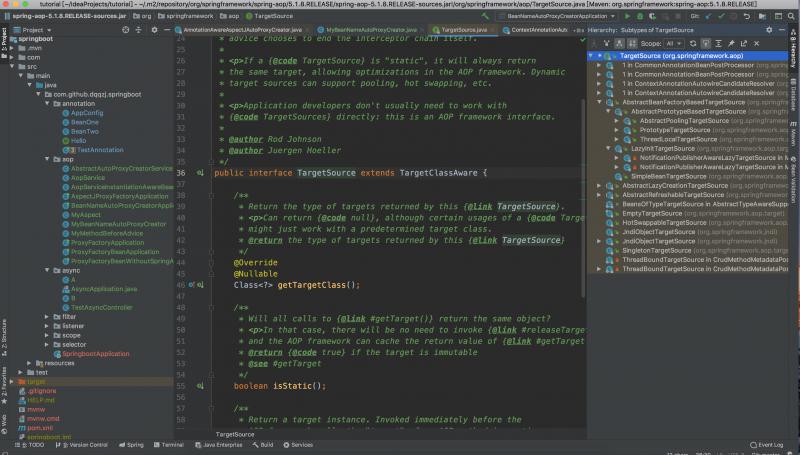Springboot原始碼分析之TargetSource
摘要:
其實我第一次看見這個東西的時候也是不解,代理目標源不就是一個class嘛還需要封裝幹嘛。。。
其實proxy代理的不是target,而是TargetSource,這點非常重要,一定要分清楚!!!
通常情況下,一個代理物件只能代理一個target,每次方法呼叫的目標也是唯一固定的target。但是,如果讓proxy代理TargetSource,可以使得每次方法呼叫的target例項都不同(當然也可以相同,這取決於TargetSource實現)。這種機制使得方法呼叫變得靈活,可以擴展出很多高階功能,如:單利,原型,本地執行緒,目標物件池、執行時目標物件熱替換目標源等等。

Spring內建的TargetSource
SingletonTargetSource
public class SingletonTargetSource implements TargetSource, Serializable { /** Target cached and invoked using reflection. */ private final Object target; //省略無關程式碼...... @Override public Object getTarget() { return this.target; } //省略無關程式碼...... }
從這個目標源取得的目標物件是單例的,成員變數target快取了目標物件,每次getTarget()都是返回這個物件。
PrototypeTargetSource
public class PrototypeTargetSource extends AbstractPrototypeBasedTargetSource { /** * Obtain a new prototype instance for every call. * @see #newPrototypeInstance() */ @Override public Object getTarget() throws BeansException { return newPrototypeInstance(); } /** * Destroy the given independent instance. * @see #destroyPrototypeInstance */ @Override public void releaseTarget(Object target) { destroyPrototypeInstance(target); } //省略無關程式碼...... }
每次getTarget()將生成prototype型別的bean,即其生成的bean並不是單例的,因而使用這個型別的TargetSource時需要注意,封裝的目標bean必須是prototype型別的。PrototypeTargetSource繼承了AbstractBeanFactoryBasedTargetSource擁有了建立bean的能力。
public abstract class AbstractPrototypeBasedTargetSource extends AbstractBeanFactoryBasedTargetSource {
//省略無關程式碼......
/**
* Subclasses should call this method to create a new prototype instance.
* @throws BeansException if bean creation failed
*/
protected Object newPrototypeInstance() throws BeansException {
if (logger.isDebugEnabled()) {
logger.debug("Creating new instance of bean '" + getTargetBeanName() + "'");
}
return getBeanFactory().getBean(getTargetBeanName());
}
/**
* Subclasses should call this method to destroy an obsolete prototype instance.
* @param target the bean instance to destroy
*/
protected void destroyPrototypeInstance(Object target) {
if (logger.isDebugEnabled()) {
logger.debug("Destroying instance of bean '" + getTargetBeanName() + "'");
}
if (getBeanFactory() instanceof ConfigurableBeanFactory) {
((ConfigurableBeanFactory) getBeanFactory()).destroyBean(getTargetBeanName(), target);
}
else if (target instanceof DisposableBean) {
try {
((DisposableBean) target).destroy();
}
catch (Throwable ex) {
logger.warn("Destroy method on bean with name '" + getTargetBeanName() + "' threw an exception", ex);
}
}
}
//省略無關程式碼......
}可以看到,PrototypeTargetSource的生成prototype型別bean的方式主要是委託給BeanFactory進行的,因為BeanFactory自有一套生成prototype型別的bean的邏輯,因而PrototypeTargetSource也就具有生成prototype型別bean的能力,這也就是我們要生成的目標bean必須宣告為prototype型別的原因。
ThreadLocalTargetSource
public class ThreadLocalTargetSource extends AbstractPrototypeBasedTargetSource
implements ThreadLocalTargetSourceStats, DisposableBean {
/**
* ThreadLocal holding the target associated with the current
* thread. Unlike most ThreadLocals, which are static, this variable
* is meant to be per thread per instance of the ThreadLocalTargetSource class.
*/
private final ThreadLocal<Object> targetInThread =
new NamedThreadLocal<>("Thread-local instance of bean '" + getTargetBeanName() + "'");
/**
* Set of managed targets, enabling us to keep track of the targets we've created.
*/
private final Set<Object> targetSet = new HashSet<>();
//省略無關程式碼......
/**
* Implementation of abstract getTarget() method.
* We look for a target held in a ThreadLocal. If we don't find one,
* we create one and bind it to the thread. No synchronization is required.
*/
@Override
public Object getTarget() throws BeansException {
++this.invocationCount;
Object target = this.targetInThread.get();
if (target == null) {
if (logger.isDebugEnabled()) {
logger.debug("No target for prototype '" + getTargetBeanName() + "' bound to thread: " +
"creating one and binding it to thread '" + Thread.currentThread().getName() + "'");
}
// Associate target with ThreadLocal.
target = newPrototypeInstance();
this.targetInThread.set(target);
synchronized (this.targetSet) {
this.targetSet.add(target);
}
}
else {
++this.hitCount;
}
return target;
}
/**
* Dispose of targets if necessary; clear ThreadLocal.
* @see #destroyPrototypeInstance
*/
@Override
public void destroy() {
logger.debug("Destroying ThreadLocalTargetSource bindings");
synchronized (this.targetSet) {
for (Object target : this.targetSet) {
destroyPrototypeInstance(target);
}
this.targetSet.clear();
}
// Clear ThreadLocal, just in case.
this.targetInThread.remove();
}
//省略無關程式碼......
}ThreadLocalTargetSource也就是和執行緒繫結的TargetSource,可以理解,其底層實現必然使用的是ThreadLocal。既然使用了ThreadLocal,也就是說我們需要注意兩個問題:
- 目標物件必須宣告為prototype型別,因為每個執行緒都會持有一個不一樣的物件;
- 目標物件必須是無狀態的,因為目標物件是和當前執行緒繫結的,而Spring是使用的執行緒池處理的請求,因而每個執行緒可能處理不同的請求,因而為了避免造成問題,目標物件必須是無狀態的。
實現自定義的TargetSource
package com.github.dqqzj.springboot.target;
import org.springframework.aop.TargetSource;
import org.springframework.util.Assert;
import java.lang.reflect.Array;
import java.util.concurrent.ThreadLocalRandom;
import java.util.concurrent.atomic.AtomicInteger;
/**
* @author qinzhongjian
* @date created in 2019-08-25 12:43
* @description: TODO
* @since JDK 1.8.0_212-b10z
*/
public class DqqzjTargetSource implements TargetSource {
private final AtomicInteger idx = new AtomicInteger();
private final Object[] target;;
public DqqzjTargetSource(Object[] target) {
Assert.notNull(target, "Target object must not be null");
this.target = target;
}
@Override
public Class<?> getTargetClass() {
return target.getClass();
}
@Override
public boolean isStatic() {
return false;
}
@Override
public Object getTarget() throws Exception {
return this.target[this.idx.getAndIncrement() & this.target.length - 1];
}
@Override
public void releaseTarget(Object target) throws Exception {
}
}實現自定義TargetSource主要有兩個點要注意,一個是getTarget()方法,該方法中需要實現獲取目標物件的邏輯,另一個是isStatic()方法,這個方法告知Spring是否需要快取目標物件,在非單例的情況下一般是返回false。
小結
本文主要首先講解了Spring是如果在原始碼層面支援TargetSource的,然後講解了TargetSource的使用原理,接著對Spring提供的常見`TargetSource`進行了講解,最後使用一個自定義的TargetSource講解了其使用方式。
